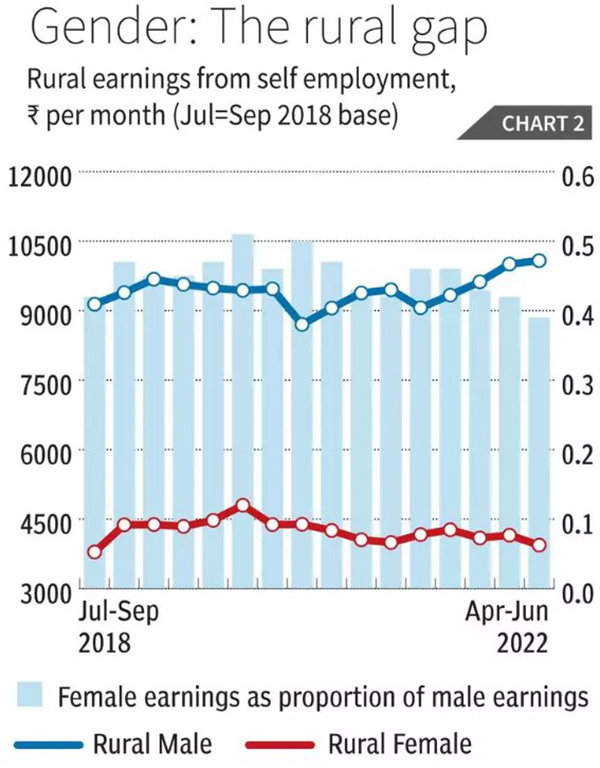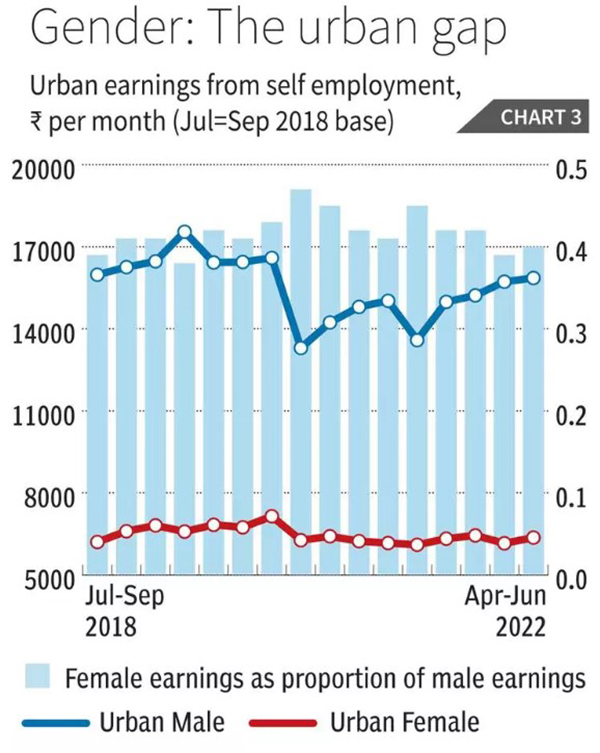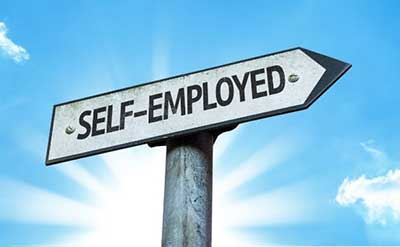Date: 05/04/2023
Relevance: GS-3: Indian Economy and issues relating to Planning, Mobilization of Resources, Growth, Development and Employment.
Key Phrases: Self-employment, absence of good quality paid employment, extremely hard to access credit, risks of production, Social Protection, lack of any compensating transfers, Periodic Labour Force Surveys, gender gap in workers' incomes.
Why in News?
- In India, over half of the workers are self-employed, with a higher proportion of women and in rural areas.
- In rural areas, it is presumed that it is the dominance of small-scale agriculture that leads to more self-employment, but in fact, self-employed workers are around half of those engaged in non-agricultural employment as well.
- In urban areas, those working without any defined employer account for around two-fifths of male workers and more than one-third of the proportion of women in some form of paid employment.
Is self-employment a choice?
- Self-employment in most cases in India (other than in farming, some small family enterprises, and skilled professionals able to work on their own terms) is rarely a choice.
- It reflects the absence of good quality paid employment, or in extreme situations, the lack of any paid employment at all.
Challenges faced by self-employed workers:
- Self-employment is typically difficult, risky, and low-paid.
- Self-employed workers bear all the risks of production, including relative price movements and changes in market conditions.
- They are also responsible for their own safety at work.
- They have to deal with a generally oppressive state at different levels and often pay extra to local officials simply to function.
- Small and micro enterprises usually also find it extremely hard to access credit and have to procure inputs on less favourable terms.
- The incomes they earn from their work are absolutely critical in ensuring anything close to a minimally decent existence. Yet remuneration from self-employment, on average, tends to be even lower than that from salaried or wage employment.
Lack of Social Protection:
- As became particularly evident during the Covid-19 pandemic, they also lack any form of social protection, other than various “universal” provisions provided by governments at the Central and State levels.
- The most obvious protection is for those covered under the National Food Security Act, who received some free food rations - but even this did not cover tens of millions of such workers and their families.
- The lack of any compensating transfers from governments during the period of huge social and economic upheaval and distress was therefore especially devastating for self-employed workers.
Falling remuneration:
- The declining remuneration from self-employment has become a significant concern.
- The real wages of self-employed workers have not only stagnated but also declined in the last three years.

- Decline in Real Wages of Self-Employed Workers
- Real remuneration from self-employment reached its peak in April-June 2019 and has been declining since then, even before the Covid-19 pandemic.
- The deflated money incomes data taken from the Periodic Labour Force Surveys by CPI for rural and urban workers, respectively, showed that real wages in terms of the base of July-September 2018 have decreased.
- Impact of Covid-19 Pandemic on Self-Employed Workers
- The pandemic and subsequent lockdowns led to a sharp decline in self-employment remuneration, especially in urban areas, where it fell by 20 percent in April-June 2020 compared to the previous quarter, and was 30 percent below the earlier peak.
- Although there has been a slight recovery, remuneration of urban self-employed workers was still 11 per cent lower in April-June 2022 than it was in April-June 2019.
- Unequal Rural-Urban Divide in Self-Employment Remuneration:
- In rural areas, the remuneration of self-employed workers peaked in January-March 2019 but has since declined further.
- There is a significant gap of around 40 percent between rural and urban earnings from self-employment, and rural incomes also fell during the first lockdown phase.
- By April-June 2022, incomes from self-employment in rural India were still 2 percent lower than they were more than two years earlier, despite the increase in agricultural output that has been hailed as an indicator of India's economic resilience.
Gender gulf:
- The gender gap in workers' incomes in India is one of the highest in the world in paid employment, and it turns out to be even greater for self-employment.


- In rural India, women in self-employment have earned only around 45 percent of what their male counterparts have earned.
- The situation for women self-employed workers is even worse in urban India, where they have earned on average less than 42 percent of what men workers earned per month.
- The ratio of women’s earnings to men’s earnings fell sharply over this period, from a peak of 51 percent in October-December 2019 to as low as 39 percent in April-June 2022.
Conclusion
- Sharp increases in economic inequality may conceal these tendencies in the aggregate macroeconomic data for a while, but eventually this stagnation or deterioration of workers’ incomes, which necessarily implies lower mass consumption demand, must also affect economic activity and investment.
- It is unfortunate that this most essential truth remains unrecognised by Indian policy makers.
- It is imperative that policymakers take steps to address economic inequality to ensure sustainable and inclusive economic growth for all.
Source: The Hindu BL
Mains Question:
Q. What are the challenges faced by self-employed workers in India, and how have their incomes been affected in recent years? Discuss the gender gap in earnings of self-employed workers in rural and urban areas, and explain the reasons behind the decline in their remuneration.






















